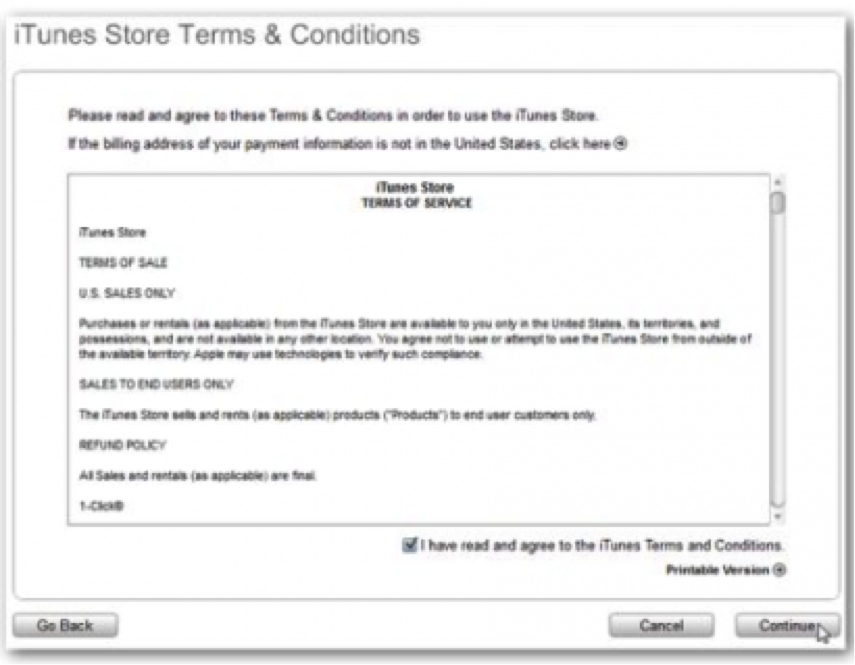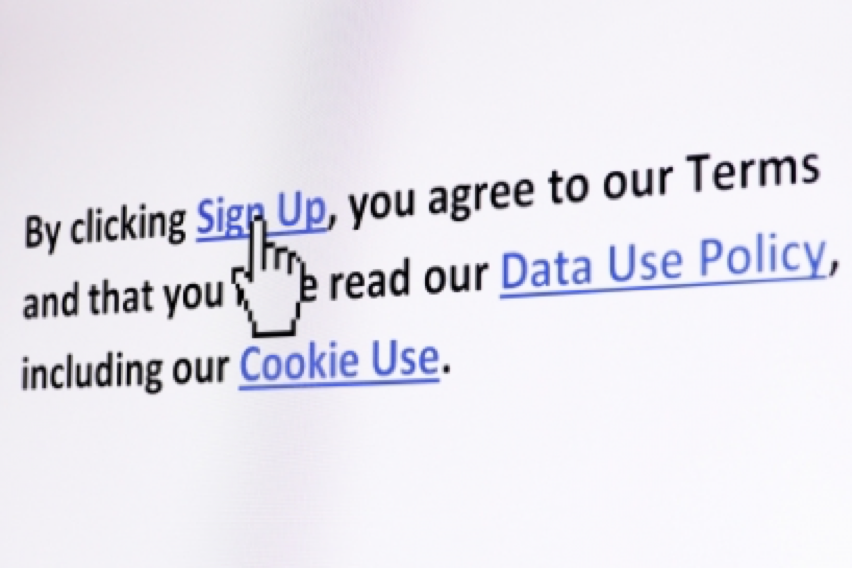
In an experiment at the University of Pennsylvania Law School a couple of years ago, more than 500 students signed up to an online service. Without exception, they all agreed to its terms and conditions.
A quarter of the students did take a quick look at the Ts&Cs. Yet no-one spotted (or at least objected to) paragraph 2.3.1, where they agreed that in exchange for using the new service, they would hand over their first-born child.
As we often explain in business writing workshops, people have very little time to read anything fully. That doesn’t mean they’re stupid or have attention span problems. It simply means that they have a lot to do, and have to make choices about which of the thousands of words thrown at them every day, they actually read.
Terms and conditions can be tricky, unsexy communications to deal with. But making them easy and interesting to read is one of the best things you can do to build customer relationships. So why don’t more organisations provide understandable Ts&Cs?

In our experience, there are a number of factors that typically contribute to making Ts&Cs boring and incomprehensible…
Usually, the focus of legal teams isn’t the customer
Legal teams are made up of highly intelligent, highly qualified people whose training has a particular use of language at its heart. On top of that, to become a great lawyer you have to be able to read, remember and apply huge volumes of difficult text.
So the professionals who create these documents start off with a complex communications style. And they sometimes have a tendency to think that if people can’t read difficult text, it’s simply because they’re not applying themselves.
On top of this is the fact that a lawyer’s role is to protect their company from risk – it’s not about helping customers understand what they’re signing up for.
So lawyer communications can be impenetrable – even to colleagues in the same organisation. This means that teams whose role includes advocating for customers often don’t understand what their organisation’s terms and conditions mean – and this makes it hard for them to rewrite or press for change.
There’s often more than one author and more than one owner
A couple of years ago, we rewrote the terms and conditions for an insurance policy. (If you’ve ever looked at the pages and pages of tiny print that accompany your insurance premium – that’s the kind of thing we’re talking about.)
It was a huge job, and we worked in close collaboration with the company’s legal, product and risk management teams to achieve it. We unpicked, section by section – asking what each word and phrase meant.
In the process of doing so, we found a lot of unnecessary repetition. The exact same messages, said in different words, appeared in a number of places throughout the entire document. The reason? The document had originally been split into sections, with a different team taking responsibility for each section. Before we started the piece of work, the document had never been looked at in its entirety. Instead, each team looked after their section, updating where they thought necessary and repeating the same caveats, conditions and qualifiers that appeared elsewhere in the text. Another outcome of this approach was that some sections contradicted others.
Why had no-one picked this up? Because the text was just far too difficult to understand without a lawyer sitting on one side of you and a reg risk person on the other.
With the legal team’s agreement – and looking at the document as a whole rather than a number of constituent parts – we removed all unnecessary repetition and the contradictions.
Terms and conditions often aren’t regularly reviewed
While bits and bobs are sometimes added to terms and conditions, they are, in our experience, rarely reviewed and reshaped.
Sometimes this is because there’s no clear, overall owner of the Ts&Cs. More often, I think, it’s because creating and maintaining legal documents is seen as such a pain, that once they’re created, no-one really wants to open that can of worms ever again.
A few years ago, we rewrote the terms and conditions of a pension. (We also rewrote the pension statement itself, but that’s a different story.)
The Ts&Cs were for a product that had been around for a long time. As and when regulation had changed, extra paragraphs had been added in. But as the decades rolled on and the company itself became far more customer-focused, it decided it was time to renew the Ts&Cs.
The interesting thing was that even the company’s own lawyers and regulatory risk managers didn’t understand a lot of the text. They understood the language, of course, but the purpose of the text had people scratching their heads. Maybe at some point in the 1970s, some of the clauses and paragraphs had been important. But as many of us sitting together throughout the project had only been in primary school at the time, we could only guess.
In the end, we stripped out almost 50% of the content of the Ts&Cs. In effect, we started again. And the result wasn’t just terms and conditions that long-term savers could understand, it was a product that the business itself could better articulate.
Changing Ts&Cs takes collaboration, diplomacy and a willingness to challenge and work together
Changing terms and conditions can take a lot of work. Rewriting Ts&Cs is a multi-disciplinary effort. You need around the table:
- Someone who represents your customers’ interests – maybe someone from marketing or customer experience
- Maybe someone who owns the product the Ts&Cs are attached to
- Lawyers
- Regulatory risk people
- People (like Wordtree) who can digest complex subject matter – and then re-write in customer-friendly ways
You have to approach the whole thing as a change project. There is going to be resistance – but you can overcome it if you keep everyone in the loop and communicate very clearly why all the extra work is important.
We’ve found that regular meetings of people whose input is necessary for things to progress is critical. Progress reports that loop in everyone who might have an interest in the project are also important.
There’s no disguising that this can be fiddly, brain-achey work. But it’s also deeply satisfying – and once you’ve cracked the formula for doing it once, you can use the same approach again and again until it becomes a process for creating new legal documents, rather than rewriting them.

Changing terms and conditions and other important documents to make them clear, logical and understandable to end users is often challenging. But the benefits of doing it differently outweigh the difficulties. They include:
Greater compliance with regulation
If you work in a regulated industry, it’s not good enough that your legal documents (including Ts&Cs) are accurate. They have to treat customers fairly too – which means they should be pretty easy to get to grips with.
All regulators stipulate that communications should “not be misleading”. But I think a form of “misleading” is “misdirection”.
I had a conversation with a regulatory risk officer once who told me: “I’d rather a customer didn’t understand than they were misled.” My brain nearly exploded. Because what she meant was that if you couldn’t understand these products, brilliant – because in that confusion you couldn’t possibly think the description was over-promising.
In more recent years we seem to be getting away from this kind of thinking, which is great – because it isn’t fair. And it certainly doesn’t comply with the spirit of regulation.
Better relationships
Communicating terms and conditions clearly is a great boost to any organisation’s brand – and to the quality of its relationships with clients and customers.
Because when you communicate the “difficult stuff” clearly, you increase trust. You’re also treating your customer as an equal.
Greater efficiencies
If you want to greatly reduce complaints and dissatisfaction – and boost understanding of your products and services both internally and externally – then you need to communicate them in a more straightforward way.
A few years ago, I rewrote a policy. The sentence in the box below saved the company an estimated six-figure sum in its first year. Why? Because it greatly reduced the number of complaints that cropped up when customers realised their insurance claims weren’t going to be successful. And dealing with complaints – particularly complex complaints – can be costly.
| Before | After |
| Failure to preserve and furnish all documentation deemed to be necessary to the determination of the case, including but not limited to receipts, hospital evaluation records, invoices and all forms of payment documentation, may result in the rejection of the case. | You must keep and share with us all the paperwork related to your claim. This could include all your hospital paperwork, bills and receipts. But it could include other paperwork too – so keep everything. |
Of course, an alternative is to do nothing – but what happens then?
If people just click to accept terms and conditions, a fair question might be, well what’s the point in launching big projects to change them? Especially if the industry you work in doesn’t have a regulator breathing down its neck?
What happens if you do nothing is you save your organisation a few thousand pounds in the short term. But in the mid-to-long term, you miss some really valuable opportunities.
You miss, for example, the opportunity to be the stand-out brand in your field – the one that prioritises customers so much that it even makes its legal documentation accessible.
You miss an opportunity to educate your clients about the product, the risks they may be taking, what they’re responsible for and what you’re responsible for. You miss an opportunity to manage expectations and offset and mitigate complaints (which saves you money and improves reputation in one hit).
Internally, you also miss an opportunity to boost cross-disciplinary collaboration – and finding ways for teams to share customer-centric approaches.
If you decide that you’d like to tackle your terms and conditions, you know where to find us. And you can learn more about our copywriting process by reading our FAQs.
